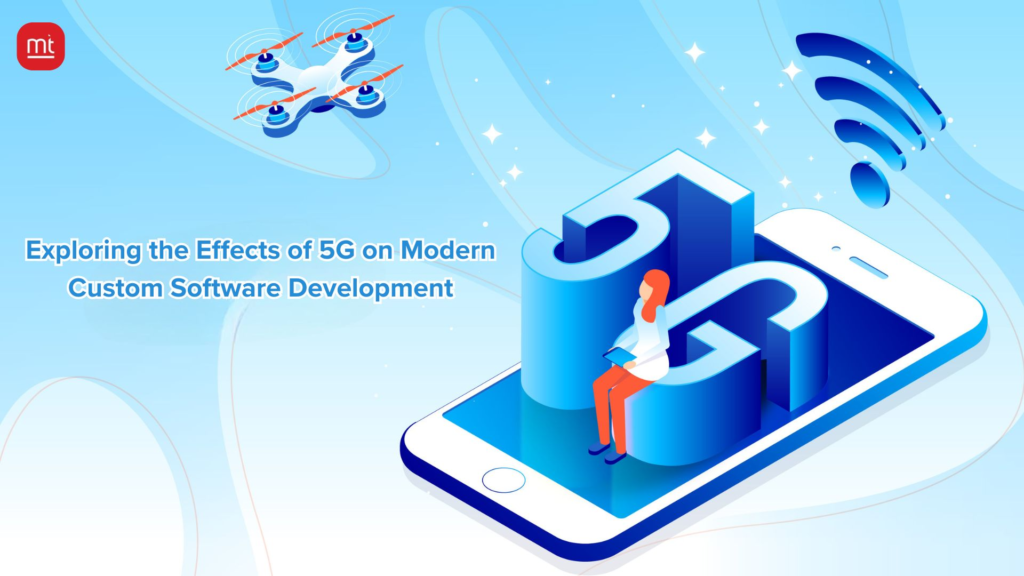Today’s digital environment is constantly changing, and one of the most revolutionary technologies that define this change is 5G. The potential of achieving faster speeds, ultra-low latency, and enhanced connectivity creates new opportunities in software development.
In particular, custom software development is experiencing a revolutionary change owing to 5G as even developers and businesses are now starting to understand how 5G could revolutionize everything from mobile applications and mobile applications to enterprise-level software products.
The global custom software development market size was estimated at USD 35.42 billion in 2023 and it is projected to grow at a CAGR of 22.5% from 2024 to 2030. This article will look at the impact of 5G on custom software development, the impact of 5G on software development trends, the software development cost involved, and why it is important for businesses to hire software developers that are conversant with 5G technology.
What is 5G Technology?
To understand how 5G affects custom software development first, let us know what 5G is and why it is so innovative. 5G is the fifth generation of mobile network technology, which has the following enhancements over the previous generation, 4G.
These are a much higher download and upload speed, a much lower ping, and a much higher capacity for connecting devices. This is not only about enhancing mobile internet; it’s about revolutionizing the way people engage with the digital environment, including custom software development.
Transformative Effects of 5G on Custom Software Development
5G’s most direct influence on software development is to create new possibilities for applying the technologies. It gives software developers a much stronger starting point to work from, as well as improved speed and the ability to support more advanced and feature-laden programs. Here’s how:
Enhanced Real-time Capabilities
A very important effect of 5G on software development is that it provides real-time data processing. In the healthcare industry, automotive, and manufacturing, the ability to transfer data almost simultaneously to analyze it is crucial. In the 5G network, latency is very low and therefore real-time decision-making is no longer bound by communication delays.
Revolutionizing Mobile App Development
The coming of the 5G is a revolution in the mobile applications development industry. With speed 100 times faster than 4G, apps can now provide users with a more fluid interface with less loading time, high quality content and more engaging features.
Higher capacity offered by 5G makes it possible to design mobile applications that include elements of AR and VR. These applications can offer more meaningful and interactive user experience that is important in industries such as retail, education, and entertainment.
Enabling Smart cities and IoT Ecosystems
5G has also paved the way for the advancement of smart cities and the further evolution of the Internet of Things (IoT). Modern smart cities are built around systems of interconnected sensors and devices that gather and share data to manage day-to-day life processes. While 5G enables custom software development to use IoT on extending these applications beyond what was achievable earlier.
Reducing Development Complexity with Edge Computing
One of the biggest opportunities that come with 5G is the transition to edge computing. Edge computing is the distributed architecture where data is processed at proximity to the source of data instead of the centralized cloud platform. This minimizes the latency and bandwidth usage, which is beneficial, especially for applications that need quick decisions to be made.
Impact on Software Development Trends
The global 5G services market size was $98.3 billion in 2023 and is projected to grow to $427.7 billion by 2028. 5G is not only impacting the performance and scalability of custom software; it also shapes the general evolution of custom software development solutions. Several key trends are emerging as a result of the 5G revolution:
Shift to Cloud-native Architecture
As 5G networks deliver higher performance, more companies are adopting cloud-native environments. Cloud-native software makes it possible to use different architectures and easily adapt to a variety of devices and platforms that characterize 5G. Microservices and containerization are on the rise to help companies develop applications that can easily be scaled up.
Focus on Security and Privacy
As 5G becomes the key to unlocking the potential of the Internet of Things and data sharing, it is clear that security must also be improved. The expansion of the data and the necessity of their real-time analysis create new risks that custom software developers should face. As the creators of encryption protocols for secure cloud services, developers have to construct solutions that can guarantee that the data is shielded while performance is optimally enhanced.
Enhanced Demand for Cross-platform Development
Since organizations are looking for ways to provide consistent experiences for consumers on various devices, cross-platform development has become even more relevant in the current world and is among the current software development trends.
Conclusion
5G has an enormous influence on custom software development as it changes the very process of creating applications and their characteristics. This means that as organizations work in this new environment, they need to embrace custom software applications for 5G. This is because by employing competent software developers and engaging the appropriate development services providers, organizations are in a vantage position to compete in the current and future market.
At ManekTech, we focus on developing custom software solutions that leverage the potential of the 5G network. If you are planning to improve your current software package or if you are planning to develop a new package from the ground up then you need our services. As a company that is well-informed about 5G technology and how it affects software development, we are here to assist you in creating products that not only answer the needs of today’s digital world but also go beyond them.


